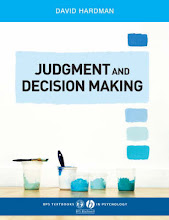Chapter 3 contains some discussion of the conjunction fallacy. People commit the conjunction fallacy when they believe that a conjunction of two (or more) events is more likely than either or those events taken individually. By contrast, probability theory tells us the opposite must be the case: two (or more) events together can never be more likely than either individual event. To put it formally:
Equation 1 P(B Λ A) = P(A) x P(B A);
or if A and B are independent then
Equation 2 P(B Λ A) = P(A) x P(B)
Chapter 3 focuses on one of the best-known explanations of the conjunction fallacy, which is the representativeness heuristic. There have been other explanations, however, but the one thing that the various accounts have in common is that the existence of the fallacy means that people are not using probability theory to reason about conjunctions.
A paper by Costello (2009) now suggests that it is premature to rule out probability theory as a component of human thinking. Consider the famous Linda problem (described in Chapter 3) whereby people read a description of "Linda" when she was a student, and then rank the likelihood of statements about what Linda might be doing now. The three key statements are:
1. Linda is a bank teller.
2. Linda is a feminist.
3. Linda is a feminist and a bank teller.
People typically rank (3) above (1). However, according to Costello's argument the values that are entered into Equations 1 or 2 are affected by random variation, or noise. This is not surprising: people's beliefs about "Linda" are likely to be vague rather than precise, hence at the moment that people are asked to think about Linda the values of (1) and (2) are likely to be drawn from a range of values.
The existence of this noise in the probabilities that people hold about (1) and (2) mean that people could use a process of thinking that implements the conjunction rule, yet produces a conclusion that would appear to be inconsistent with it. The conjunction fallacy is most likely to occur when the probability of one constituent is low and the probability of the other constituent is high, a prediction that is born out by previous findings in the literature.
Costello also suggests that the variation around the probability values for uncertain events will be reduced when people are explicitly asked to estimate probabilities for those events, as compared to the procedure in the classic conjunction studies where people are asked to rank order events. Thus, asking for probability estimates should reduced the conjunction fallacy, a result that has also been found in previous research.
Another prediction is that the conjunction fallacy should be reduced when people are asked to estimate the probabilities of the constituents before estimating the probability of the conjunction of those constituents (as opposed to estimating the probability of the conjunction first). This is because first estimating the probabilities of A and B is likely to reduce the extent to which they vary when the probability of the conjunction is being estimated. On the other hand, variability is less constrained when estimating the probability of the conjunction first.
Reference
Costello, F.J. (2009). How probability theory explains the conjunction fallacy. Journal of Behavioral Decision Making, 22, 213-234.
Corrections and clarifications
There is an error in Figure 3.3. This is the tree diagram representing Eddy's (1982) medical problem. For the branch representing P(Negative | Cancer) the probability should be 0.208, NOT 0.028. Accordingly, the number at the rightmost end of the branch should be 0.0028, NOT 0.00028.
This does not affect the answer to the problem stated in the text, which remains 0.077.
My thanks to Chloe Turner (one of my students) for pointing this out.
Tuesday, 2 June 2009
Subscribe to:
Post Comments (Atom)
About Google Analytics
This website uses Google Analytics, a web analytics service provided by Google, Inc. (“Google”). Google Analytics uses “cookies”, which are text files placed on your computer, to help the website analyze how users use the site. The information generated by the cookie about your use of the website (including your IP address) will be transmitted to and stored by Google on servers in the United States . Google will use this information for the purpose of evaluating your use of the website, compiling reports on website activity for website operators and providing other services relating to website activity and internet usage. Google may also transfer this information to third parties where required to do so by law, or where such third parties process the information on Google's behalf. Google will not associate your IP address with any other data held by Google. You may refuse the use of cookies by selecting the appropriate settings on your browser, however please note that if you do this you may not be able to use the full functionality of this website. By using this website, you consent to the processing of data about you by Google in the manner and for the purposes set out above.




No comments:
Post a Comment